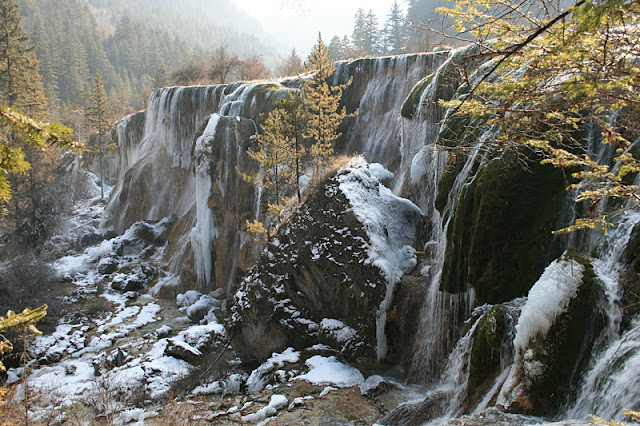Jiuzhaigou and Huanglong are both famous for their natural beauty and karst topography. Recent years, millions of tourists are attracted to these places. Local administration authority has now imposed stricter control on the motor traffic and tourist flow in the park areas. If you want to avoid the crowd, winter will be a better season to visit Jiuzhaigou.
 |
| (One of the water sources of Yangtze River is from the Min River head) |
Jiuzhaigou and Huanglong are in the southern part of the Min Mountains. Water from the glaciers flow down the Min River and into the Yangtze River. Within half an hour bus ride from the airport, you can reach the Min river head.
Jiuzhaigou has different faces for each of the four seasons. Autumn is colourful and the busiest season. The beauty of Jiuzhaigou in winter is ice and peace.
 |
| (One of the Tibetan village in Jiuzhaigou) |
If you like hiking, you can plan for two-days walk along the Y-shaped valley in Jiuzhaigou. The karst topography forms beautiful landscapes and scenery. Well maintained walking paths are built along the valleys. Proper signage along the road can help you to find the way. Sometimes, tourist crowds can be disturbing. We prefer to avoid the crowds in order to enjoy the natural scenery in peace.
 |
| (Image of mountain range reflected in the calm water surface) |
 |
| (Frozen lake in the upper range of Jiuzhaigou) |
 |
| (Ice and snow covered the waterfall) |
 |
| (Beautiful ice crystals formed along the river stream) |
Calcium carbonate deposited in the surface of fallen trees along the lakes. With light reflection, it formed colourful coatings.
 |
| (Five colour pond in Jiuzhaigou) |
Another karst topograhy that we have encountered before is in the Plitvice Lakes, Croatia. In comparison, the areas covered in Jiuzhaigou is bigger in size.
 |
| (Photo taken in Pilvice Lakes, Croatia) |








